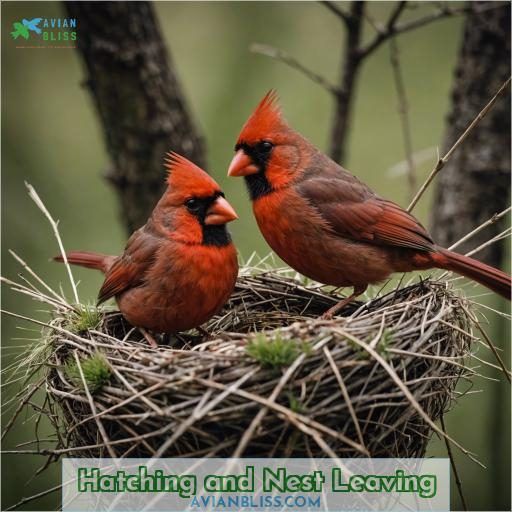This site is supported by our readers. We may earn a commission, at no cost to you, if you purchase through links.
 As a lover of backyard birds, you’ll be delighted to know that cardinals typically begin laying their eggs in April, though nesting can start as early as February. Cardinals are prolific breeders, with females capable of producing multiple clutches throughout the spring and summer months.
As a lover of backyard birds, you’ll be delighted to know that cardinals typically begin laying their eggs in April, though nesting can start as early as February. Cardinals are prolific breeders, with females capable of producing multiple clutches throughout the spring and summer months.
Each clutch contains 2-4 oval-shaped, light eggs that are white to pale green with brown or gray speckles – a natural camouflage against predators. The female cardinal will incubate these eggs for 11-13 days before they hatch, with the male providing food during this time.
To discover more fascinating details about these vibrant songbirds and their nesting habits, keep reading.
Table Of Contents
Key Takeaways
- Cardinals typically begin laying their eggs in April, with the possibility of nesting starting as early as February.
- A female cardinal can lay multiple clutches throughout the breeding season, each containing 2-4 eggs that are white to pale green with brown or gray speckles.
- The incubation period for cardinal eggs is 11-13 days, during which the male cardinal provides food for the incubating female.
- Cardinal eggs are vulnerable to predators, but their color and speckling provide natural camouflage, aiding in their survival.
When Do Cardinals Lay Eggs?
Cardinals typically lay their eggs between March and September.
The first brood starts around March, and the second brood starts from late May to July.
The exact timing can vary depending on the location and climate, but in general, cardinals begin breeding in late winter to early spring.
The female cardinal lays 2-5 eggs, which she incubates for about 11 to 13 days.
Egg Laying Months
As the temperatures warm in spring, cardinals often begin nesting as early as February and typically lay their first clutch of eggs in April. While the timing can vary based on location and environmental conditions, these vibrant red birds are usually busy with egg-laying by the time April arrives.
Cardinals Typically Begin Laying Eggs in April
Cardinals typically begin laying eggs in April, marking the start of their breeding season. However, nesting can start as early as February.
During this period, the male cardinal displays elaborate courtship behaviors, including singing and feeding the female. The female chooses her mate based on factors such as ornamentation, including the size of the male’s black face mask and the color of his plumage and bill.
Once a pair has formed, they build a nest together, with the female laying 2-4 eggs, which are incubated for 12-13 days. The young cardinals hatch and leave the nest after 9-11 days.
Nesting Can Start as Early as February
Nesting can start as early as February for cardinals. Here are five key points to understand this aspect of their nesting behavior:
- Cardinals typically begin nesting in February, with some pairs starting even earlier.
- The female cardinal is responsible for building the nest, which is a bowl-shaped structure wedged into a fork of small branches, shrubs, or vines.
- The nest is usually placed 1-15 feet above the ground, hidden in dense foliage.
- The male cardinal may assist in gathering materials for the nest, but the female does most of the construction.
- Cardinals usually don’t reuse their nests, building a new one each year after raising their brood.
Egg Laying Frequency
Cardinals are quite the diligent parents, typically laying their eggs from April, though some early birds start as soon as February. A female cardinal can lay multiple clutches per season, each containing 2-5 precious eggs.
These eggs, oval in shape and light in weight, showcase a stunning array of colors from white to pale green, speckled with brown or gray – a natural camouflage against predators.
As these eggs rest in carefully constructed nests, they’re a proof of the cardinals‘ commitment to the next generation’s survival.
Incubation Period
Incubation duration is a vital aspect of cardinal nesting behavior. The female cardinal incubates the eggs for 11 to 13 days. During this period, the male cardinal procures sustenance for the incubating female.
The success of hatching hinges on various factors, including incubation temperature, egg survival, and egg predation. The female cardinal is solely responsible for incubating the eggs, and the male doesn’t partake in this process.
The incubation period is typically shorter than the nestling phase, which endures for 9 to 11 days after hatching.
Hatching and Nest Leaving
When the Northern Cardinal lays eggs, the nesting process begins. The female cardinal builds the nest, typically in dense shrubs, bushes, or small trees that provide good cover and protection. The nest is a cup-shaped structure made of twigs, grass, and bark, usually built in the dense foliage of trees and shrubs. Once the nest is built, the female lays 2-5 eggs, which are whitish and marked with brown, lavender, and gray. The female does most of the incubating, and the male brings her food. After about 12 days, the eggs hatch, and the young cardinals are cared for by both parents until they can fly well, which is approximately 9-11 days after hatching.
The nesting process is a critical time for cardinals, as they’re vulnerable to predators such as snakes, squirrels, raccoons, cats, crows, jays, hawks, and owls. To protect their young, cardinals often nest near their previous nest, which may offer some help in reducing predation. They also display adaptability to a wide range of environments for nesting, showcasing their ingenuity in finding safe and hidden places to build their homes.
Egg Color and Size
Cardinals lay small, round eggs that are about 1 inch long and 0.75 inches wide (2.5 x 2 cm). These eggs are a bluish-green color with brown spots, which helps to camouflage them in the nest.
The eggs are incubated for about 12 days, and the young birds leave the nest after 9-11 days.
The eggs are laid in a nest made of twigs, leaves, bark, and grass, which is usually built by the female in a dense shrub or tree.
Cardinal eggs are also vulnerable to predators such as raccoons, snakes, and squirrels, so the parents attend to the eggs to safeguard their survival.
Nesting Behavior
Cardinals are known for their unique nesting habits, and understanding these behaviors can provide valuable insights into their breeding and parenting patterns. Here are four key aspects of cardinal nesting behavior:
- Nest location: Cardinals prefer to build their nests in dense foliage, typically 1-15 feet above the ground. They choose locations with protection, such as thorny shrubs or impenetrable vegetation.
- Nest materials: The female cardinal is responsible for building the nest, using materials such as twigs, leaves, bark strips, rootlets, and pine needles.
- Nest construction: Nest construction begins in late winter (February/March) and involves the female carefully weaving the chosen materials into a cup-shaped structure. The male may occasionally contribute materials, but the architectural responsibility rests solely with the female.
- Nest design: Cardinal nests are typically 4 inches in diameter and 2-3 inches in height, with a woven base and a soft lining made of grasses, leaves, or feathers.
Number of Eggs
As you’ve seen, cardinal couples are quite the busy birds, often engaging in multiple nesting throughout their breeding season, which spans from February to September. Regarding egg clutches, expect to see about three eggs, although one to five isn’t unusual. These eggs are a sight themselves, with a unique appearance of buff white to light green, speckled with darker marks—a natural artistry at play.
You’ll typically find their nests cleverly hidden in dense shrubbery or vine tangles, a strategic choice for safety.
Egg Incubation
Regarding cardinal eggs, the hatching time is paramount. The incubation period generally spans 11 to 13 days. During this interval, the mother cardinal is charged with maintaining the eggs’ warmth and safety. The father cardinal assists by providing sustenance to the mother. Upon hatching, both parents collaborate to nourish the young, primarily with insects. The fledglings depart the nest after 9 to 11 days.
Egg care and shelter are vital during this time. The mother cardinal guarantees that the eggs remain at an optimal temperature and humidity for appropriate development. Predators of eggs, such as raccoons or serpents, pose a risk to the eggs, thus the mother must also shield them from these predators.
Egg Attending
As a cardinal owner, you’re probably keen to provide the best care for your feathered companion. One essential aspect of their well-being is ensuring the safety and cleanliness of their eggs. In the wild, cardinals face various threats to their eggs, including predators and parasites. Here’s what you need to know about egg protection, egg camouflage, egg sanitation, and egg predators:
- Egg Protection: Cardinals are known to be attentive parents, and they take great care in protecting their eggs. The female typically lays 2-4 eggs, which are incubated for 11-13 days. During this time, the male brings food to the female, who stays on the nest to incubate the eggs. Once the eggs hatch, the female broods the chicks for at least 2 days before both parents start feeding them insects.
- Egg Camouflage: Cardinal eggs are typically white with brown spots, which helps them blend in with their surroundings. This camouflage helps protect the eggs from predators.
- Egg Sanitation: To maintain cleanliness, cardinals may remove sharp eggshell fragments to protect their newly hatched brood from harm. This also helps prevent microbial infestations and pungent-smelling cues that might alert nest predators.
- Egg Predators: In the wild, cardinal eggs are susceptible to predation by various animals, including snakes, birds, and small mammals. Brown-headed cowbirds, which aren’t related to cardinals, are known to take cardinal eggs from the nest and sometimes eat them.
- Egg Parasites: Cardinals aren’t the only birds that face the threat of parasitism. Some birds, like cuckoos, lay their eggs in the nests of other species to avoid incubating their own eggs. These parasitic birds may damage the host’s eggs to prevent the parasite’s eggs from being damaged when the host lays its eggs.
Egg Hatching
Egg hatching in cardinals is a fascinating process that involves careful incubation, hatching, and the emergence of tiny, vulnerable hatchlings. Cardinals typically begin laying eggs in April, with nesting starting as early as February. The female cardinal incubates her eggs** for twelve to thirteen days, during which she takes 40-minute intervals to sit on the eggs and then takes a five to fifteen-minute break. The male cardinal is responsible for protecting the female during this time and ensuring she’s well-fed.
Once the eggs are ready to hatch, the baby inside the egg cracks at the shell from the inside, creating a small hole. The baby cardinal then wiggles and moves around inside the egg, stretching itself to crack the shell further until it’s free from its shell. This process can take about twenty to twenty-five minutes. The mother cardinal may assist in helping the baby emerge from the shell. The baby that emerges is now called a hatchling.
A cardinal baby will stay in the nest until it becomes a fledgling, which takes seven to thirteen days. At this stage, the fledgling will have all of its feathers and will leave the nest while hopping around and learning to fly.
Cardinal eggs are small and delicate, with a 2.2-2.7 cm length and a width of 1.7-2 cm. They’re typically laid in multiflora rose, honeysuckle, and ash plant varieties and are very vulnerable to predation. Small mammals such as squirrels, chipmunks, and shrikes, as well as blue jays, hawks, owls, and snakes, are potential predators of cardinal eggs.
Egg predation is a significant concern for cardinals, with egg mortality being high due to predation of entire nests, removal of single eggs, or desertion of nests by cardinals after one or more eggs have been removed. However, brown-headed cowbirds, which aren’t related to cardinals, are known to parasitize cardinal nests by laying their eggs in cardinal nests. The cardinal can’t tell the difference between a cowbird and cardinal egg and will raise the cowbird as its own. This can lead to reduced reproductive success for cardinals.
Frequently Asked Questions (FAQs)
What is the egg color of cardinal eggs?
Your cardinal eggs are a beautiful greenish or bluish white, with delicate brown spots. These stunning eggs are the perfect start to the cardinals’ nesting journey every spring.
How many eggs do cardinals lay?
Ah, the cardinal’s secret boudoir! These feathered romantics typically lay a modest clutch of 2-3 eggs, nature’s colorful ode to their boundless passion. Now, shall we discuss their steamy mating rituals?
What is the incubation period for cardinal eggs?
You’ll be glad to know that cardinal eggs typically hatch after about 12-13 days of incubation. The female does all the hard work, keeping those precious eggs warm until her chicks arrive!
How long does it take for cardinal eggs to hatch?
Did you know cardinal eggs hatch in a mere 11-13 days? That’s fast! Once the female lays her 3-4 eggs, she’ll sit tight, keeping them cozy until those little ones emerge.
What is the size of cardinal eggs?
The cardinal eggs measure around 1 inch long and 3/4 inch wide. They’re a greenish or bluish white color with brown speckles. With proper nesting conditions, you can expect the eggs to hatch in about 12-13 days.
Conclusion
Remarkably, cardinals can produce up to 4 clutches per breeding season, showcasing their prolific nature.
The female cardinal will incubate the 2-4 light-colored, speckled eggs for 11-13 days before they hatch.
Nesting may commence as early as February, though cardinals typically lay eggs in April.
Understanding the nesting secrets of these vibrant songbirds can heighten your appreciation for the wonders of backyard wildlife.












